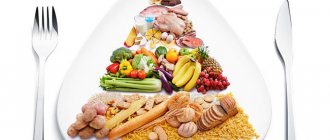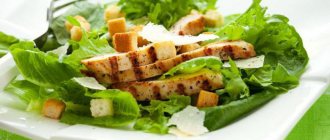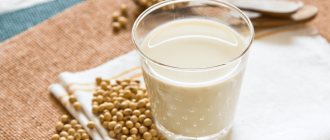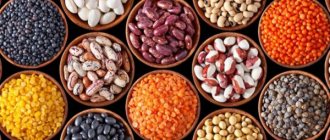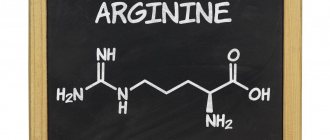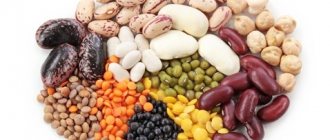A person can feel young and healthy only when all the conditions are created in his body for the proper flow of metabolic and recovery processes and metabolism. The main indicator of these conditions is the level of acid-base balance. The number 7 on the scale means the optimal pH balance level. Anything below 7 is acidic, anything above is alkaline. To keep the body in good shape, experts strongly recommend following an alkaline diet.
- Alkaline products
Acid-base balance and health
Biochemical processes in the body occur with the participation of water, oxygen and hydrogen. Through the main fluid (blood), oxygen dissolved in water enters the cells. Their lack has a detrimental effect on the functioning of internal organs.
Blood pH is the only indicator that normally remains at the same level - 7.4 +/- 0.5. When there is an excess of acids in the body, acidosis develops; when alkaline substances accumulate, alkalosis develops. That is why it is vital for organs and systems to develop in a normal environment.
The slightly alkaline indicator is the same for any person. Exceeding or decreasing the pH level of the blood leads to alkalization or acidification of the body. The consequence of this is the development of diseases and unfavorable symptoms.
Purines and uric acid
Purines (despite the fact that they are classified as harmful substances that provoke the development of gout) are the most important compounds that are part of all living organisms without exception and ensure normal metabolism. Moreover, purines are the basis for the formation of nucleic acids, which are responsible for the storage, hereditary transmission and implementation of information (remember that nucleic acids are the well-known DNA and RNA).
When cells die, purines are destroyed with the further formation of uric acid, which acts as a powerful antioxidant that protects our blood vessels and prevents premature aging.
But as soon as the level of uric acid in the body is exceeded, it turns from a “friend” into an “enemy”, since, accumulating in the kidneys, joints and other organs, it leads to the development of gout, rheumatism, hypertension, osteochondrosis, urolithiasis and kidney stones. In addition, excess uric acid weakens the activity of the heart and contributes to blood thickening.
Therefore, it is extremely important to control the level of uric acid in the body, and for this it is enough to monitor your diet, which should not be oversaturated with foods containing large quantities of purines.
What foods contain purines?
Important!
The average daily intake of purines for healthy people who do not have problems with the kidneys, which are responsible for removing excess uric acid from the body, is 600 - 1000 mg. At the same time, products of plant origin containing a large amount of purines are not dangerous to health, since they are suppliers of organic acids that help eliminate excess uric acid directly.
The highest purine content is found in the following products:
- yeast;
- veal (especially tongue and thymus);
- pork (especially heart, liver and kidneys);
- dried white mushrooms;
- anchovies;
- sardine;
- herring;
- mussels;
- cocoa.
Moderate amounts of purines are found in the following foods:
- bovine lungs;
- bacon;
- beef;
- trout;
- tuna;
- carpe;
- cod;
- seafood;
- poultry meat;
- ham;
- lamb;
- perch;
- rabbit meat;
- venison;
- lentils;
- pike;
- sprats;
- mackerel;
- beans;
- halibut;
- dry sunflower seeds;
- scallop;
- zander;
- chickpeas;
- raisins sultanas.
The least amount of purines is present in the following foods:
- barley;
- dry peas;
- asparagus;
- cauliflower and savoy cabbage;
- broccoli;
- meat products;
- flounder;
- oatmeal;
- salmon;
- canned mushrooms;
- peanut;
- spinach;
- sorrel;
- leek;
- cottage cheese;
- cheese;
- eggs;
- bananas;
- apricot;
- prunes;
- dried dates;
- rice;
- pumpkin;
- sesame;
- sweet corn;
- almond;
- hazelnut;
- green olives;
- quince;
- celery;
- grape;
- walnuts;
- plum;
- asparagus;
- tomatoes;
- bakery products;
- eggplant;
- cucumbers;
- peaches;
- strawberry;
- a pineapple;
- avocado;
- radish;
- apples;
- pears;
- kiwi;
- beet;
- boiled potatoes in their skins;
- raspberries;
- cherry;
- sauerkraut;
- Red Ribes;
- carrot;
- gooseberry.
Causes of acid-base imbalance
Alkaline foods (listed below) are aimed at preventing acidosis - acid-base imbalance. It is characterized by an excess amount of acids and an excess content of hydrogen ions.
The pathological process is influenced by several factors:
- Improperly organized diet. Consumption of processed and refined foods, confectionery, coffee, and carbonated drinks increases the load on the enzyme and lymphatic system. They do not have time to restore pH, which leads to the accumulation of acids, toxins and free radicals.
- Excessive medication use. The toxic load due to the use of chemically synthesized substances quickly acidifies the body and worsens the human condition.
- Lack of physical activity. Sedentary work, stress and overwork lead to the accumulation of acids.
- Non-compliance with drinking regime. The cells must be bathed in water. The less liquid supplied, the lower the pH.
The acid-base balance is restored by adopting a healthy lifestyle (proper nutrition, drinking regimen, physical activity).
Creatine
This is a nitrogen-containing carboxylic acid that provides energy metabolism not only in muscle cells, but also in nerve cells. This is a kind of “warehouse” of energy from which the body, if necessary, receives strength, not to mention increasing endurance.
Benefits of creatine
- Significant increase in muscle mass.
- Accelerating the rate of recovery after intense physical activity.
- Removing toxins.
- Strengthening the cardiovascular system.
- Reducing the risk of developing Alzheimer's disease.
- Promoting cell growth.
- Improving brain function, namely enhancing memory and thinking.
- Accelerates metabolism, which promotes fat burning.
If we talk about the dangers of creatine, then with moderate consumption of products containing this substance, no side effects will be observed, which has been confirmed by many studies.
But!
Ingesting creatine in excessive doses can lead to the development of obesity, as well as overload of systems and organs responsible not only for the absorption, but also for the processing of various food components.
Important!
Creatine is produced by the human body itself from amino acids, but still a certain part of it must be supplied with food.
What foods contain creatine?
Creatine is extremely sensitive to heat, so during the heat treatment of products, a significant part of it is destroyed.
Main food sources of creatine:
- beef;
- pork;
- milk;
- cranberry;
- salmon;
- tuna;
- herring;
- cod.
How to determine acidification in the body
Increased acidity is indicated by some signs that you can determine yourself.
These include:
- pain in the back, joints and muscles;
- brittleness of hair and nails;
- problems with the gastrointestinal tract;
- decreased performance, fatigue;
- dizziness and headaches;
- dry skin;
- increased incidence of infectious diseases;
- hair loss;
- brittle bones and dental problems;
- "Orange peel";
- stroke or heart attack;
- development of a cancerous tumor.
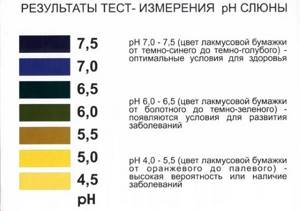
A pH below 7.4 indicates increased acidity in the tissues. If one or more symptoms occur, the likelihood of an acid-base imbalance is high. It can also be determined using litmus (indicator) paper. The test is carried out at home using saliva or urine.
Acidity is measured daily, based on the results of which the average value is calculated:
- Saliva pH = 7.0 + 0.5 indicates a normal environment in the body. There is no serious cause for concern. In this case, litmus acquires a color from blue to dark blue;
- pH = 6.0 + 0.5 – favorable conditions for the development of pathologies. The color of the paper varies from green to marsh;
- pH = 4.0 + 1.5 – high risk of developing chronic diseases. Litmus turns yellow or orange.
The average urine pH per week should be 6.3-6.8. It is better to carry out the test periodically over 2-3 weeks. A urine pH below 5.5 is a cause for serious concern and consultation with a doctor.
Omega acids
Omega fatty acids belong to the class of essential fatty acids, since they are not synthesized in the human body (with the exception of monounsaturated omega-9 acids), and, therefore, their only source is food.
The unsaturated fats most in demand by the body are omega-3 (or linoleic acid), omega-6 (or linolenic acid) and omega-9 (or oleic acid).
The benefits of omega acids
- formation and protection of all body cells;
- participation in the synthesis of both protein and hormones;
- maintaining a normal balance of cholesterol in the blood;
- elimination of inflammation;
- normalization of blood sugar;
- stimulating the development of brain molecules.
A lack of omega acids leads to dry skin, brittle nails, constipation, high blood pressure, joint pain, memory impairment, and in the worst case, schizophrenic disorders.
Interesting Facts!
The complex of omega-3 and omega-6 acids is also called vitamin F). But experts do not classify omega-9 acids as essential substances, but in vain, because for their production the body requires certain conditions, one of which is normal metabolism (this condition is almost impossible to fulfill in a life full of stress and poor nutrition).
So, let’s look at the benefits of each of the omega acids listed, paying special attention to which foods will help fill their deficiency in the body.
Omega-3 fatty acids
The benefits of omega-3 acids
- The production of so-called tissue hormones, which take part in many processes occurring in the human body.
- Ensuring the formation of cell membranes, which ensures the full functioning of the brain, nervous and reproductive systems.
- Providing the body with energy.
- Slowing down blood clotting.
- Preventing the development of diseases such as atherosclerosis and hypertension by maintaining all blood vessels in normal condition.
- Improving heart function.
- Normalization of metabolic processes.
- Ensuring the proper functioning (and in children, the formation) of the nervous system and brain.
- Strengthening the immune system.
- Prevention of the development of allergic diseases.
- Strengthening the musculoskeletal system.
- Regulating digestion.
- Elimination of inflammation.
- Removing toxins, which prevents early aging and the development of cancer.
- Regulates fat metabolism, which helps fight excess weight.
- Acceleration of the wound healing process.
- Regulation of emotional background.
Excess omega-3 acids
Excessive levels of omega-3 acids in the body threaten the following disorders:
- development of hypotension;
- irritability and increased anxiety;
- general weakness;
- weak muscle tone;
- disruptions in the functioning of the pancreas;
- increased bleeding of wounds.
Lack of omega-3 acids
A deficiency of these acids leads to acne, itching and dandruff.
In addition, the following violations may occur:
- depression;
- memory impairment;
- joint pain;
- constipation;
- cardiovascular disorders.
Omega-6 fatty acids
The benefits of omega-6 acids
- Reducing the negative manifestations of PMS.
- Strengthening hair and nails.
- Maintaining skin elasticity.
- Prevention of cancer and cardiovascular diseases.
- Reducing the manifestation of allergies.
- Prevention of premature aging.
- Elimination of foci of inflammation.
- Normalization of reproductive function.
- Decreased levels of sex hormones.
Important!
Lack or deficiency of omega-3 fatty acids leads to the fact that omega-6 acids from beneficial become harmful, namely:
- contribute to the development of atherosclerosis and other heart diseases;
- increase the manifestations of hypertension;
- promote the development of inflammatory processes and allergic reactions;
- trigger skin aging mechanisms;
- provoke the appearance of acne and dermatitis;
- contribute to the development of late toxicosis.
Therefore, it is extremely important to adhere to a certain proportion between these acids, which is 5:1, where 5 parts are for products containing omega-6 acids, and one part is for products with omega-3 acids.
Excess omega-6 acids
Excessive consumption of foods containing omega-6 acids can cause:
- weakened immunity;
- increased blood pressure;
- disruption of the cardiovascular system;
- development of inflammatory processes.
Lack of omega-6 acids
With a deficiency of omega-6 acids, a person feels constant fatigue, he is predisposed to depression, not to mention memory loss, hair loss, the development of nervous diseases, weakened immunity, high blood pressure and obesity.
Omega-9 fatty acids
The benefits of omega-9 acids
- Preventing the accumulation of cholesterol.
- Maintaining optimal weight.
- Strengthening the immune system.
- Strengthening blood vessels.
- Promoting hormone synthesis.
- Normalization of metabolic processes.
- Prevention of blood clots and the development of diseases such as cancer and diabetes.
- Improving the digestion process.
- Elimination and prevention of constipation.
- Memory improvement.
- Supplying the body with energy.
- Maintaining healthy skin, hair, nails.
Lack of omega-9 acids
A deficiency of omega-9 acids leads to joint pain, the development of arthritis and arthrosis, drying out of the mucous membranes, digestive disorders, memory impairment, increased blood pressure, depression and weakened immunity.
What foods contain omega acids?
Omega-3 in foods
The daily intake of omega-3 acids is about 1 – 2.5 g (in the presence of certain diseases, the norm of omega-3 acids may change).
Food sources of omega-3 acids:
- sea fish (halibut, trout, salmon, herring, mackerel, cod, tuna);
- black and red caviar;
- seafood;
- livestock meat;
- domestic eggs;
- vegetable oils;
- seeds;
- nuts;
- legumes;
- leafy greens;
- soybeans and by-products;
- melon;
- fish fat;
- wheat and oat germ;
- cabbage of different varieties;
- zucchini.
Important!
During heat treatment (especially during frying), omega-3 acids are greatly destroyed, so it is advisable to consume vegetables and fruits fresh or steam them. If we talk about fish, then the healthiest fish is considered lightly salted.
Omega-6 in foods
The daily intake of omega-6 acids for adults is 8–10 g.
These fatty acids are present in the following foods:
- cold pressed vegetable oils;
- raw sunflower seeds;
- sesame;
- maque;
- pumpkin seeds;
- sprouted wheat;
- eggs;
- pork lard;
- butter;
- pine nuts;
- pistachios;
- sea fish;
- red meat.
Important!
Breast milk contains large amounts of omega-6 and omega-3 acids, and these acids are present in an easily digestible form, for this reason it is important to breastfeed your baby for as long as possible.
Omega-9 in foods
Sources of omega-9 fatty acids include:
- unrefined vegetable oils;
- fat (both pork and beef);
- tofu;
- nuts of different varieties;
- cod oil;
- avocado;
- seeds;
- pork;
- poultry meat.
Important!
Omega-9 acids have a fairly high chemical stability, that is, they do not oxidize during storage and heating, which cannot be said about omega-3 and omega-6 acids, which are easily oxidized and, therefore, acquire carcinogenic properties.
What happens with high acidity
An increase in acidity deprives cells of oxygen, energy, and the normal course of biochemical processes. The accumulation of carbon dioxide in them, as well as the lack of alkaline minerals leads to acidification in the tissues. An excess of free radicals is formed, the body's defenses are reduced, and pathogenic microorganisms multiply.
As a result, chronic pathologies develop (arthrosis, osteoporosis, heart and vascular diseases, obesity), including oncology (a pH value of 6 indicates the development of cancer).
Tannin
Tannin (this most useful substance has another name – tannic acid) has a beneficial effect on the human body, namely:
- eliminates inflammatory processes;
- helps stop bleeding;
- neutralizes the effects of bee stings;
- helps cure various skin diseases;
- binds and removes waste, toxins and heavy metals from the body;
- neutralizes the negative effects of microbes;
- strengthens blood vessels;
- eliminates gastrointestinal disorders;
- prevents the development of radiation sickness, as well as leukemia.
What foods contain tannins?
Important!
It is advisable to consume products containing tannins (and any other tannins) on an empty stomach or between meals, otherwise they bind to the proteins of the food itself and therefore do not reach the mucous membranes of both the stomach and intestines.
Food sources of tannins:
- green and black tea;
- thorn;
- pomegranate;
- persimmon;
- dogwood;
- quince;
- cranberry;
- strawberries;
- blueberry;
- black currant;
- grape;
- nuts;
- spices (cloves, cinnamon, cumin, as well as thyme, vanilla and bay leaf);
- legumes;
- coffee.
Important!
The appearance of a feeling of viscosity in the mouth when eating a particular product indicates the tannin content in it.
Why are alkaline products recommended?
Alkaline foods (list later in the article) normalize the ratio of acids and alkalis in the body and restore pH. Eating vegetables, greens and fruits prevents the accumulation of toxins and free radicals, thereby cleansing the body.
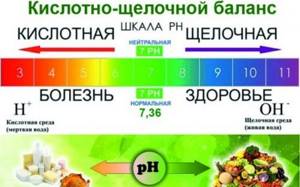
The vitamins, minerals and trace elements they contain have a beneficial effect on the immune system as a whole, lead to improved condition of the skin, hair and nails, and increase performance.
Notes
To maintain an optimal level of blood alkalinity, a person needs to consume 80% alkali and 20% acid per day. Some foods, entering the body and passing through all stages of digestion and metabolism, can leave alkaline and acidic waste in the body. They are called alkaline-gene and acid-gene. These include:
- Wheat flour, brown rice, and some other grains are moderately acidic in their natural form. But when ingested or processed, they become more acidic.
- All types of grains, legumes, meat products and eggs are acidic in nature. And vegetables and fruits are alkaline.
- All citrus fruits are initially associated with sour foods. However, when processed in the body, they have an alkaline effect.
- Legumes belong to the category of sour foods. But sprouted legumes become more alkaline.
- Milk is alkaline only in its raw form. Heated, boiled milk, all dairy products will be classified as acidic.
List of foods with the highest pH values
Alkaline foods - the list with the highest pH is as follows:
- Lemon. When it enters the gastrointestinal tract, an alkali is released. It is good to drink water with lemon juice in the morning. When combined with sugar, it, on the contrary, releases acid.
- Onions, parsley and other greens. They have a high pH. They contain vitamins and minerals. Removes toxins, increases immunity, strengthens blood vessels.
- Root plants (carrots, radishes, rutabaga, beets, horseradish). They have a high pH. Improves intestinal motility.
- Celery and cucumber. They are classified as moderately alkaline products and quickly neutralize accumulated acids.
- Garlic. Helps not only maintain acid-base balance, but also increase the body's defenses. The product has good antifungal and antibacterial properties.
- Cruciferous vegetables (green beans, cabbage, broccoli). Their unique composition contains indoles - natural substances with anti-cancer properties.
- Avocado. Normalizes pH in the body, improves immunity.
- Wheat and barley sprouts. Contains vitamins, minerals, microelements. They have antifungal and anticancer properties.
- Sea vegetables (algae). They are sources of chlorophyll, an alkalizing substance.
- Chamomile and green tea. They have a good alkalizing and anti-inflammatory effect.
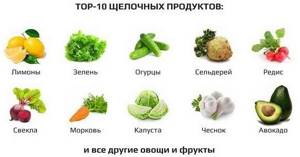
Including the above products in the diet helps normalize pH levels, cleanse and heal the body.
Prohibited foods (acidic)
A considerable part of acidic foods is a valuable source of proteins and calcium, phosphorus, but if abused, it causes acidification of the body. Therefore, its amount should be limited to 20-30%.
- meat and fish, especially fatty varieties, offal and seafood;
- dairy products, eggs;
- candies, sweet pastries made from white flour, wheat bread;
- corn (vegetable, cereal, vegetable oil);
- butter, margarine;
- sugar in any form;
- walnuts, peanuts;
- chocolate and any products containing cocoa;
- vinegar, mayonnaise, soy sauce;
- black and green tea, coffee;
- sweet soda, juices with added sugar;
- beer, strong alcoholic drinks.
Fast food, canned food, and semi-finished products are also prohibited. For an alkaline diet, it is best to prepare your own meals.
Alkaline Ingredients Table
Alkaline foods (the list is given below) depending on the pH value are divided into highly alkalizing, alkalizing and slightly alkalizing.
| Highly alkalizing | Alkalinizing | Weakly alkalizing |
| Stevia (natural sweetener) | Maple syrup | Honey |
| Lemon, lime, grapefruit, watermelon, papaya, mango | Grapes, melon, kiwi, peach, apple, pears, dates, dried grapes | Pineapples, oranges, bananas, cherries, olives, persimmons, potatoes |
| Leeks, parsley, garlic, spinach, green beans and cabbage, radishes | Celery, zucchini, rutabaga, pumpkin, lettuce, beans, cucumbers | Tomatoes, carrots, cabbage, peas |
| Almond | Chestnut fruit | |
| Olive oil, black cumin oil | Flax oil | |
| Germinated barley sprouts | Millet, brown rice | |
| Colostrum, breast milk | Milk and cheese (goat), whey | |
| Lemon water, herbal tea, fresh vegetable juices | Ginger drink | Green tea, freshly squeezed fruit juices |
Aspirin
Aspirin (or acetylsalicylic acid) is a derivative of salicylic acid.
The benefits of aspirin are undeniable:
- Preventing the formation and so-called adhesion of blood clots.
- Stimulating the formation of a large number of biologically active substances.
- Activation of enzymes that break down proteins.
- Strengthening blood vessels and cell membranes.
- Regulating the formation of connective, cartilage, and bone tissue.
- Preventing vasoconstriction, which is an excellent prevention of the development of heart attacks and strokes.
- Relieving inflammation.
- Elimination of febrile conditions accompanied by an increase in body temperature.
- Relieving headaches (aspirin thins the blood and, consequently, reduces intracranial pressure).
Important!
As you know, with long-term use of aspirin in the form of tablets, various side effects can be observed, therefore (in order to avoid various complications) for preventive purposes, it is better to consume products of plant origin containing acetylsalicylic acid. Natural products do not cause any serious complications.
What foods contain aspirin?
Acetylsalicylic acid is found in many fruits and vegetables. All the products listed below must be included in the menu of older people and those who suffer from hypertension and other cardiovascular diseases.
Main food sources of aspirin:
- apples;
- apricots;
- peaches;
- gooseberry;
- currant;
- cherry;
- strawberry;
- cranberry;
- raspberries;
- plum;
- prunes;
- oranges;
- cucumbers;
- tomatoes;
- grape;
- raisin;
- melon;
- Bell pepper;
- seaweed;
- kefir;
- onion;
- garlic;
- cocoa powder;
- red wine;
- beet;
- citrus fruits (especially lemons).
Fish oil also has powerful aspirin-like properties.
Alkaline diet
The alkaline diet is gaining popularity. It is based on the consumption of foods with a high pH. These include dishes made from vegetables, fruits, herbs and other products of plant origin. Their main advantage is acid neutralization.
They also contain fiber, vitamins, minerals and antioxidants, which have a beneficial effect on the functioning of the intestines and the immune system as a whole.
Any product that comes to a person with food releases either an alkali or an acid in the body. The consumption of thermally processed food leads to fermentation and acidification processes. Meat and dairy dishes and baked goods release acid in large quantities.
Benefit
Including fresh foods in your diet creates a healthy alkaline environment. Neutralization of acids prevents the leaching of calcium from bones, restores and cleanses the body. The nutritional system is popular because it helps to lose excess weight by forming the habit of a healthy lifestyle.
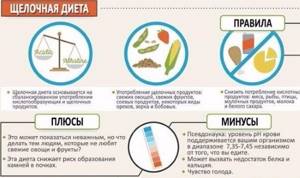
An alkaline or alkaline diet helps:
- prevention of a number of diseases (urolithiasis, osteoporosis, obesity, oncology);
- improving metabolism;
- body weight control;
- maintaining youth, vigor and ability to work;
- full functioning of all organs and systems;
- increasing the body's defenses.
Following an alkaline diet, after 7 days you can notice the following changes:
- improves complexion and skin tone;
- intestinal motility is normalized;
- flatulence is eliminated;
- efficiency increases;
- memory, mood and general well-being improves.
The method of Robert Young, the author of the alkaline diet, is designed for several weeks (3-4). This much time is required to normalize the pH of the blood, as well as remove toxins and waste from the body.
Peculiarities
The alkaline nutrition system implies compliance with certain rules.
They concern the careful selection of ingredients:
- Preference is given to alkaline foods: fruits, vegetables, herbs, berries, low-fat fish, sesame seeds, and pumpkin seeds. Cereals (buckwheat, oats, brown rice) are allowed. Olive, sunflower, and linseed oil are used as a dressing. Alkaline food should make up at least 75% of the daily diet.
- The restriction applies to acidic foods: meat, milk, eggs, legumes, fish, baked goods, as well as coffee and tea. They make up no more than 25% of the daily diet. In this case, preference is given to lean varieties of meat and fish (veal, chicken, turkey, hake, cod, pollock, flounder). Dishes based on them are consumed no more than 2 times a week.
- Completely excluded: alcohol, canned and pickled foods, products based on animal fats.

The daily menu includes 4-5 meals, meals are fractional. In between meals, drink clean water, herbal tea, and freshly squeezed juice. Sugar is replaced with maple syrup or honey, salt - with natural herbs and spices. The transition to a normal diet after the diet course should be gradual, which will take several days.
Advantages and disadvantages
The benefits of dietary nutrition allow you to follow the instructions without compromising your health.
These include:
- satiety of foods with a small amount of food consumed. A feeling of fullness is achieved by eating foods high in fiber and low in energy value. This allows you to lose excess weight with a minimum of calories;
- food availability;
- no strict restrictions when choosing ingredients. It is important to remember the 3:1 ratio in favor of alkaline products;
- cleansing and healing the body.
The main rule : you should switch to a diet gradually, giving up smoking and drinking alcohol. The body needs some time to readjust.
The disadvantage of the diet is:
- inability to lose weight quickly. Gradual weight loss is one of the main rules of an alkaline diet;
- the need to reconsider food preferences for sweet and meat lovers;
- replenishment of calcium reserves by taking a vitamin-mineral complex.
Improving the health of the body, as well as preventing the development of chronic pathologies, is the main goal of an alkaline diet. Weight loss is a secondary goal. This should be taken into account when choosing a diet.
Contraindications
Switching to alkaline foods is not for everyone. Children, pregnant and lactating girls, athletes, and manual workers are not recommended to resort to an alkaline diet. These categories of people are characterized by high energy costs, and food restrictions do not have the best effect on replenishing strength and energy.
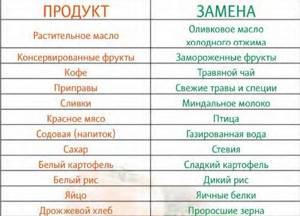
Some chronic pathologies are contraindications to following the diet menu:
- diseases of the digestive system in the acute stage (gastritis, stomach ulcers, colitis);
- low stomach acidity;
- kidney disease;
- osteoporosis;
- diseases of the heart and blood vessels.
If you do not follow the recommendations of specialists, even minor changes in your diet can be harmful to your health.
Diet stages
The alkaline diet involves 3 stages. The duration of each of them is 7 days.
They are distinguished depending on the effect of diet on the body:
- Stage one (days 1-7). Characterized by rapid loss of extra pounds. During this time, adaptation occurs, waste and toxins are eliminated. In the first days, you are allowed to eat black bread (in small quantities) and drink coffee (no more than 1 cup per day). Flour and sweet foods are prohibited. Following the recommendations, by the end of the week you will lose up to 5 kg (depending on the initial weight).
- Stage two (8-14 days). Slowing weight loss. Cleansing of the body continues and well-being improves. Stomach acidity decreases. Bakery products are completely excluded from the diet; instead of coffee, they drink herbal infusions or green tea.
- Third stage (15-21 days). Consolidation of the result. The body is cleansed and restored, the desired pH balance is achieved. Weight loss during this period is about 1 kg.
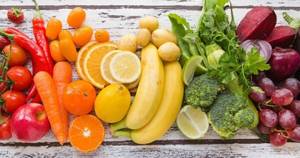
In the first days, darkening of the eyes and slight dizziness may occur. The state of health returns to normal by the end of the first week. In case of a sharp deterioration of the condition, the diet should be stopped.
Sample menu for 7 days
The detailed menu is designed for a week. Fruits, dried fruits or nuts are used as snacks between main meals. Peanuts and walnuts increase acidity and should be excluded from the diet. Drink drinking water throughout the day.
| Breakfast | Dinner | Dinner | |
| Monday | Whole grain oatmeal porridge with fruits/berries, 1 cup of green tea | Vegetable soup; steamed green beans; freshly squeezed fruit juice | Eggplant with cheese, baked in the oven; fruit salad |
| Tuesday | Homemade yogurt; crispbread (toast) with jam | Creamy vegetable soup; 1 boiled egg | Fish (baked); a fresh vegetable salad; Herb tea |
| Wednesday | Brown rice with vegetables; rosehip decoction | Boiled potatoes; stewed cabbage with onions and carrots; fresh juice | Veal (boiled); vegetable salad; homemade yogurt |
| Thursday | Boiled eggs (2 pieces); grain bread (1 slice); 1 grapefruit | Boiled chicken breast; a fresh vegetable salad; 250 ml. milk | Vegetable salad with tomato and cheese; herbal infusion |
| Friday | Whole grain oatmeal porridge with dried fruits (prunes/dried apricots); toast with honey; freshly squeezed fruit juice | Beetroot soup (holodnik); baked mackerel; chicory (drink) | Boiled potatoes with vegetable oil; fresh vegetables (cucumber, tomato); mint tea |
| Saturday | Vegetable cutlets (from potatoes and carrots); Herb tea | Cream soup of mushrooms and vegetables; Bran bread | Vegetable cabbage rolls with sour cream; rosehip infusion |
| Sunday | Cottage cheese with fruits or berries; Herb tea | Vegetable soup; Bran bread | Buckwheat porridge with stewed beef; salad of vegetables and sprouted wheat; tea with mint and lemon balm |
The menu can be adjusted and compiled independently. The main thing is to take into account the pH of the products, as well as the general rules of an alkaline diet.
Adviсe
- Avoid eating after 19:00. After this hour, it is recommended to only drink herbal or ginger tea .
- Eat slowly and chew your food thoroughly, do not rush. Sometimes, it is the habit of eating “convenient” food on the go that forces you to go on a diet in the future.
- If you still can’t give up alcohol, sugar, or coffee forever, don’t worry. Once a week, as a way to “treat yourself,” you can eat a chocolate bar, drink aromatic coffee or a glass of dry wine.
- Don't neglect fruits as a dessert or snack.
- Flaxseed oil is very valuable for the body. Therefore, you can drink a tablespoon of this oil in the morning, on an empty stomach, and season your salads with it. But remember that you can consume no more than 100 g per day.
- Do not drink liquids during meals, as this impairs the digestion process. The drinks recommended by this diet, water, ginger and herbal tea, should be drunk half an hour before meals and an hour after.
- Choose products with the most natural composition.
Acid-base balance according to I. P. Neumyvakin
The main recommendations of Professor I.P. Neumyvakin for maintaining acid-base balance are:
- Consume the least amount of meat and other acidic foods, the most water and alkaline ingredients. Processed meat products acidify the body, lead to the formation of free radicals, and wash calcium from the bones. This also applies to refined products and confectionery products. According to the professor, it is better to drink water with natural minerals, since running water contains a low pH (5.4). Human cells need to bathe in water. The norm is 1.5 liters per day.
- Limiting medications. The professor assures that drugs are a source of profit for pharmaceutical companies and unscrupulous doctors. The lack of natural composition in them, an excess of chemically synthesized substances is the result of acidification of the body, premature aging, and the development of side effects of drugs.
- Maintaining an active lifestyle. To achieve acid-base balance, the professor recommends moving more, taking breaks during sedentary work, and playing sports.
- Organization of short fasting. To improve your health, drink only water for 2-3 days. During this period, a good alkalizing effect is achieved.
- Eating alkaline foods (fruits, vegetables) with peels. It contains all the most valuable things.
- Organization of nutrition, as well as smoking cessation for pregnant women. A person is born with a constant pH value. Normally it is 7.1. According to doctors' observations, in 3 out of 10 newborns the acid-base balance is disturbed. This indicates the child’s predisposition to chronic pathologies. According to the professor, the indicator was influenced by the mother’s lifestyle and the quality of her diet.
Conclusion: for the coordinated functioning of the enzyme system, gastrointestinal organs, as well as the prevention of chronic diseases, you should organize a proper diet, lead a healthy lifestyle, and monitor your drinking regime.
Phosphates
Speaking about salts of oxalic acid, one cannot fail to mention phosphates, which are salts and esters of phosphoric acids.
Today, phosphates are ubiquitous in human life, as they are found in detergents, foods, medications, and wastewater.
Phosphates are used as moisture-binding agents in the processing of meat and fish.
In addition, salts of phosphoric acids are used in the confectionery and dairy industries: for example, phosphates loosen dough and impart uniformity to cheeses and condensed milk.
Briefly, the role of phosphates in the food industry can be reduced to the following points:
- an increase in the water-binding and emulsifying abilities of muscle tissue proteins (as a result, elastic and juicy sausage “flaunts” on our tables, and all these qualities are due not to the high quality of the meat itself, but specifically to the presence of phosphates in meat products);
- reduction in the rate of oxidative processes;
- promoting color formation in meat products (phosphates provide a beautiful pink color to sausages, frankfurters, balyks and sausages);
- slowing down fat oxidation.
But!
There are certain established standards for the content of phosphates in food products, which cannot be exceeded so as not to cause serious harm to health.
Thus, the maximum permitted phosphate content per 1 kg of meat and fish products is no more than 5 g (in general, this figure varies between 1 and 5 g). However, often unscrupulous producers of meat and fish products violate these standards. For this reason, it is better to consume meat and fish dishes prepared by yourself, minimizing (or better yet, eliminating) the consumption of store-bought meat and fish products.
Phosphates present in many products (sweets that contain large amounts of dyes and flavor enhancers are especially dangerous) provoke the development of the following reactions:
- skin rashes;
- disturbance of mental reactions (we are talking about hyperactivity and impulsiveness in children, weakening of concentration, excessive aggressiveness);
- disturbance of calcium metabolism, which leads to fragility and brittleness of bones.
Important!
If an allergy to phosphates occurs, you should avoid foods containing additives such as E220, E339, E322, since these substances can provoke severe reactions within 30 minutes.
What foods contain phosphates?
As mentioned above, phosphates are present in meat and fish products, canned seafood, processed cheese, canned milk, and carbonated drinks.
In addition, phosphates are present in many sweets.
Alkaline foods for psoriasis
Psoriasis is a non-infectious skin pathology that is chronic in nature. To treat and prevent exacerbations of the disease, it is important to follow a properly selected diet, the purpose of which is to maintain acid-base balance.
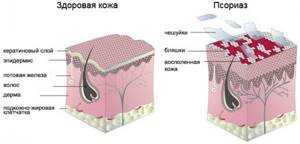
A special feature of the diet for psoriasis is compliance with the rules of nutrition:
- The daily diet is designed in such a way that 1/3 includes plant-based alkaline foods (fresh fruits and vegetables), 1/3 – protein foods (lean meats, nuts, chicken protein), 1/3 – cereals and dried fruits.
- Ingredients that can cause an allergic reaction are excluded from the menu: citrus fruits, honey, tomatoes, strawberries, red peppers.
- The diet must include vegetable oils, as well as foods rich in fiber and vitamins A and D. Eating vegetable salads with oil, buckwheat and oatmeal, and beef liver will benefit the skin.
- A diet for psoriasis involves cleansing the body. Fasting lasts no more than 2 days. During this period, they drink water; at the end of this period, prepare a salad from root vegetables.
Within 2 weeks of dietary nutrition, the condition of the skin improves, the functioning of the gastrointestinal tract is normalized, and overall immunity is increased.
During pregnancy and lactation

. According to doctors, any strict diets during pregnancy and breastfeeding are contraindicated.
Alkalization provides sufficient vitamins and fiber, but reduces the supply of calcium and essential amino acids. Without these substances, the body of the mother and baby will suffer greatly.
For cancer
By consuming alkaline foods, it is possible to adjust the pH, which leads to the destruction of cancer cells and an increase in the activity of lymphocytes. Moreover, it manifests itself at a pH of 7.3 and higher. The use of an alkaline diet promotes the release of diseased cells and the destruction of the fibrous membrane that protects cancerous tissue.
The basis of alkaline nutrition against cancer is the following recommendations:
- The consumption of freshly squeezed juice from vegetables and herbs occurs immediately after its preparation. To supply the body with dietary fiber, several whole ingredients are eaten;
- It is prohibited to take black pepper and other seasonings, soy sauce, cucumber pickle, sauerkraut, and olives. That being said, turmeric, black walnut herb and sheep's sorrel are powerful anti-cancer foods.
The diet includes parsley, celery, mustard greens, green beans, and spinach. Don't forget about broccoli, cauliflower, green onions, cucumbers, seaweed, sprouted barley, garlic.
Beets, carrots, and zucchini are consumed in moderation.
Signs of excessive oxidation in the body
Most protein products that are recommended to you by less than knowledgeable people as a guarantee of weight loss are capable of oxidizing, upsetting this very balance. That’s why, if you decide to lose weight on the Kremlin diet (read here about the Kremlin diet) or other similar ones, in which meat, poultry, eggs, and dairy products abound, then most likely this will lead to gradual oxidation of the body.

Moreover, these products do not taste sour at all; they simply release acid during processing .
Why is excess acid so dangerous? Here's what:
- Have you ever experienced a feeling of overwhelming fatigue in the morning? Do you feel sleepy all the time during the day, even though you've had enough sleep? Do you ever feel like “a cart has passed through your body?” - these are signs of excessive oxidation of the body.
- An excess of acidic products neutralizes alkalis, while reserve reserves are used, which are contained in bones, teeth, and blood. This leads to the development of osteoporosis, tooth decay, and skin becoming loose. A lack of calcium and magnesium leads to muscle pain and the development of cramps and a feeling of numbness in the limbs.
- The signal about calcium deficiency is sent directly to the brain. The body responds to this by releasing calcium into the blood, which is then not used for its intended purpose, but is deposited inside the excretory organs. This is how stones appear in the kidneys and gall bladder, urolithiasis and various cysts develop.
- The risk of developing cancer increases, since cancer cells actively develop in an acidic environment.
- Oxidation contributes to the development of cataracts and clouding of the lens.
- The cardiovascular system also suffers, which is forced to work under overload.
- Anxiety, irritability, insomnia, swelling appear, immunity decreases, frequent colds, ailments, and weakness occur.
- Many organs begin to wear out, metabolism slows down, and the digestive system works worse.

Once you start eating alkaline foods, these ailments can go away on their own, as the body begins to work in the correct mode. An acid-alkaline diet for weight loss simultaneously cleanses and heals the body .
Watch this video that explains why eating alkaline foods is so important:
For gout
The main recommendations for organizing nutrition for joint inflammation are:
- complete exclusion from the diet of foods that increase the concentration of uric acid in the blood. These include baked goods, canned food, smoked products, beans, margarine, mushrooms, and sorrel. Alcohol, beer, coffee, and grape-based drinks are prohibited. All of these foods contain purines, a source of uric acid;
- moderate consumption of beets, cauliflower, asparagus, onions, rhubarb, spinach and celery. The restriction applies to plums, tomato juice and honey;
- It is allowed to eat porridges made from cereals, citrus fruits, dried fruits, and vegetable salads.
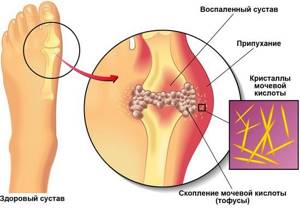
Drinks for gout include water from natural sources, herbal infusions, green tea, and cucumber juice. Be sure to take fish oil.
Some general recommendations
If you understand the principle of menu planning, you can easily create an alkaline diet menu for yourself for a week or longer.
Potatoes are also very useful for these purposes , which, not entirely deservedly, are often excluded from diets due to their high starch content. Believe me, there are many other, more harmful foods that many eat constantly and do not even realize how many harmful substances they contain. If you need to quickly achieve balance, you can include 1-2 baked or boiled jacket potatoes in your daily menu - it will not harm your figure.

Another important tip: the ratio of greens and protein dishes on one plate should be 3:1.
Dishes made from alkaline foods
Dishes based on alkaline foods are not only healthy, but also satisfying. Their preparation takes a minimum of time. The main thing is to think through the menu in advance and prepare the necessary ingredients.
First course recipes
First courses are included in any diet, including alkaline ones.
- Broccoli soup is a healthy and satisfying dish. To prepare it, take 500 grams. broccoli, a bunch of celery, 3 potatoes, 1 cup spinach. The ingredients are cut into cubes and sent to cook over low heat. After preparing the soup, the ingredients are ground in a blender until pureed. Season the finished dish to taste.
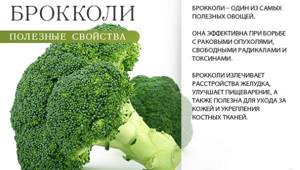
- You can diversify your alkaline menu with almond-carrot soup. First, 120 g is soaked overnight. almonds, in the morning it is washed and passed through a blender with 500 ml of water. The resulting mass is filtered to obtain almond milk. Then proceed to vegetables and herbs. Grind 200 gr. carrots and 40 gr. parsley (dill). A clove of garlic is passed through a press. The resulting mixture is combined with almond milk and blended with a blender. Before eating, the dish is seasoned with herbs, spices and salt to taste.
Second courses
Second courses from alkaline products can be prepared according to the following recipes:
- Vegetable cutlets with flax seeds. To prepare them you will need 130 g. sweet pepper, 50 gr. carrots, 50 gr. sunflower seeds, 30 grams of almonds and flax seeds. Garlic, vegetable oil, pepper and salt are added to taste. The flaxseed is soaked overnight. Vegetables are cut into strips. Then all the ingredients are placed in a blender and crushed. The mixture is seasoned, mixed and cutlets are formed from it.
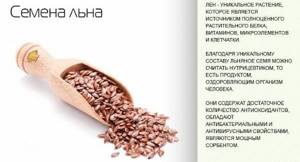
- Cabbage rolls made from lettuce leaves. Of the products you will need 250 grams. cucumbers, 80 gr. peeled seeds, 80 gr. leeks, 80 gr. salad Sunflower seeds are pre-soaked, then the water is drained and placed in a blender. Add 50 grams to them. green onions. The crushed mass is combined with chopped cucumbers, everything is mixed and salted. The composition is alternately laid out on lettuce leaves, and vegetable cabbage rolls are formed in the form of envelopes. To prevent them from opening, they are tied with the remaining leeks.
Salads
The alkaline diet menu includes dishes made from fresh vegetables and fruits. Nutritious salads are prepared on their basis.
- A salad made from fresh cucumbers, sweet peppers and pumpkin seeds is rich in vitamins and microelements. To prepare it you will need 1 medium-sized cucumber, 1 red pepper, parsley (70 gr.), lettuce (70 gr.). The first two ingredients are cut into strips, chopped lettuce and parsley are added to them. The vegetable mixture is combined with ground sesame seeds (30 g) and pumpkin seeds. Everything is thoroughly mixed. The dish is seasoned with olive oil. Salt is added to taste.
- Another healthy recipe is green asparagus, arugula and radish salad. The ingredients used are arugula (80 gr.), cucumbers (200 gr.), green asparagus (80 gr.), radishes (130 gr.). The vegetables are chopped and mixed thoroughly. 40 grams are added to them. chopped basil and parsley. The dish is seasoned with lemon juice and vegetable oil.
Porridge
Porridge is a healthy and satisfying product. And if you add vegetables or nuts to it, the nutritional value of the dish only increases.
- A delicious recipe is buckwheat with the addition of almonds and vegetables. First soak 60 grams. almonds overnight, and in the morning they are crushed in a blender. Cereals (100 g) are washed and boiled. You will also need parsley (20 gr.), sweet pepper (200 gr.), garlic (1 clove). The greens and pepper are chopped, the garlic is passed through a press. The porridge is combined with almonds, vegetables and herbs. Lemon juice (15 g) and sunflower oil are used as a dressing. Salt is added to taste.
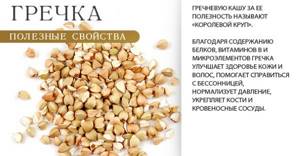
- You can also include sprouted wheat porridge with fruit and nut filling in your diet. You will need 150 g of cereals, 250 g of bananas, 100 g of prunes, 50 g of walnut kernels. Bananas and prunes are finely chopped and then ground with wheat in a blender until smooth. The dish is sprinkled with walnuts. If desired, the porridge is decorated with tangerine slices.
Alkaline nutrition is a properly organized diet that includes foods with a high pH. Cooking and combining dishes from the permitted list is not at all difficult. The main thing is to take into account the recommendations of specialists and monitor any changes in the body on the way to achieving your goal.
Author: HeLga89
Oxalic acid
Conventionally, oxalic acid is divided into organic and inorganic. In the first case, this acid, supplied by fresh vegetables and fruits, is a substance valuable for human health, which supplies the body with microelements such as iron and magnesium necessary for hematopoiesis. In addition, organic oxalic acid stimulates sluggish bowels.
Benefits of Organic Oxalic Acid
- Normalization of digestion.
- Helping stop bleeding.
- Relieving inflammation.
- Activation of the activity of internal organs (especially the liver).
- Promoting the formation of bile.
- Improvement of intestinal activity.
But oxalic acid in inorganic form is a substance that enters the body with boiled vegetables and fruits. Thus, during the heat treatment of vegetables, this acid combines with free calcium, forming oxalic acid salts (oxalates), which contribute to the formation of kidney stones, the development of articular rheumatism and arthritis. In addition, oxalates destroy teeth and bones, and also negatively affect sexual function in men. But “the devil is not as terrible as he is portrayed,” and therefore, with moderate consumption of boiled vegetables containing oxalic acid, you will not face any of the above violations, because this acid is easily excreted from the body in the urine.
Excess oxalic acid is manifested by the following symptoms:
- weakness;
- abdominal cramps and indigestion;
- burning of mucous membranes;
- nausea.
In severe cases, difficulty breathing and disruption of the cardiovascular system may occur.
What foods contain oxalates?
First of all, as mentioned above, oxalates are found in cooked vegetables and fruits.
Oxalic acid salts are also present in vinegar, mustard, chocolate, fatty meats, sweets, wine berries, cookies, jam, dough products, ice cream.
What foods contain oxalic acid?
The harmless amount of oxalic acid salts is 50 mg per 100 g of food.
The leaders in the content of this acid are:
- greens (sorrel, rhubarb, spinach, as well as celery and parsley);
- cocoa;
- coffee;
- chocolate;
- tea;
- beet;
- lemon and lime (especially the peel);
- cannon;
- buckwheat;
- almond;
- cashew nuts.
In addition, oxalic acid is found in the following products:
- pepper;
- ginger;
- carrot;
- onion;
- culinary poppy;
- tomatoes;
- chicory;
- raspberries;
- strawberry;
- green bean;
- cabbage;
- cucumbers;
- apricots;
- bananas;
- currant;
- eggplant;
- mushrooms;
- lettuce leaves;
- legumes;
- pumpkin;
- apples;
- gooseberry;
- blackberry;
- potato;
- mango;
- pomegranate;
- oranges;
- radish;
- nuts;
- wheat germ;
- corn.
Table of mineral content of selected foods
To make your knowledge of the acid-base balance even stronger, I made a small table for the alkaline diet, which indicates the exact ratio of the content of acidic and alkaline elements .
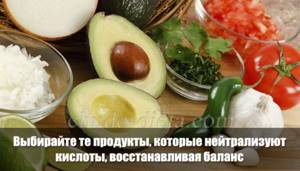
By looking at this plate, you will know exactly which foods are good for you and which ones are better to avoid for a while. When your condition returns to normal, you will again be able to eat a little more acidic foods.
| Product Name | Content of acid and alkaline elements in% | |
| Acids | Alkalis | |
| Eggs | 72,7 | 27,3 |
| Rice | 72,6 | 27,4 |
| White bread | 72,0 | 28,0 |
| Beef, lean pork, chicken | 70,8 | 29,2 |
| Cottage cheese | 70,1 | 29,9 |
| Pasta | 69,7 | 30,3 |
| Fish | 68,8 | 31,2 |
| Legumes | 61,8 | 38,2 |
| Salo | 58,9 | 41,1 |
| Butter | 56,1 | 43,9 |
| Cheese | 54,4 | 45,6 |
| Rye bread | 53,9 | 46,1 |
| Nuts | 52,2 | 47,8 |
| Cocoa | 51,8 | 48,2 |
| Beet | 45,6 | 54,4 |
| String beans | 42,3 | 57,7 |
| Spinach | 40,9 | 59,1 |
| Tomatoes | 38,0 | 62,0 |
| Strawberry | 37,4 | 62,6 |
| Potato | 36,6 | 63,4 |
| Onion | 35,5 | 64,5 |
| Carrot | 28,9 | 71,1 |
| Apples | 27,3 | 72,7 |
| Gooseberry | 25,5 | 74,5 |
| cucumbers | 25,0 | 75,0 |
| Plums | 23,1 | 76,9 |
| Lemons | 20,5 | 79,5 |
Perhaps it will be more convenient for you to “read” this table using the interactive graph that I made for you:
